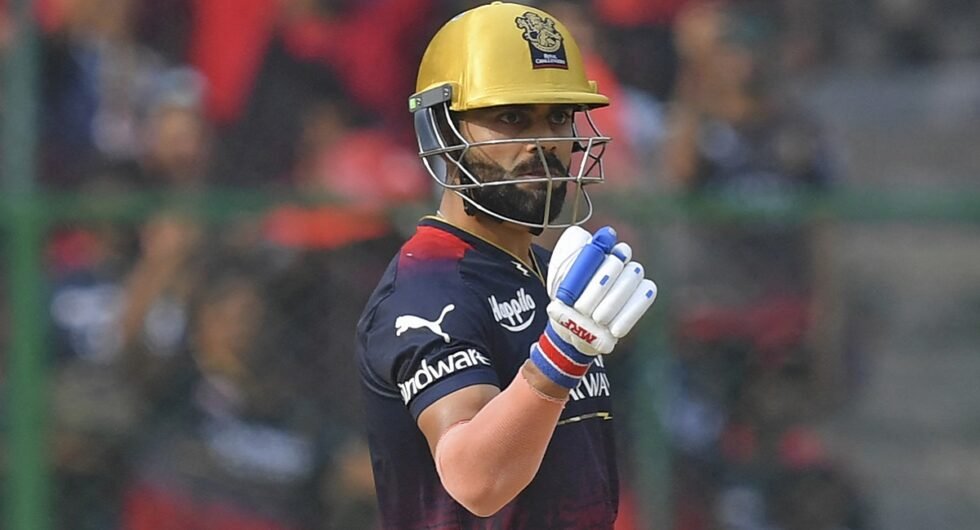Explained: Why IPL teams should consider opening the bowling to Virat Kohli with two spinners

 by Abhishek Mukherjee
by Abhishek Mukherjee
@ovshake42 5 minute read
Given the difference between Virat Kohli’s strike rates against pace and spin, teams may want to open bowling with two spinners against him in a Twenty20 match, writers Abhishek Mukherjee.
Rewind to last year’s T20 World Cup semi-final at Adelaide Oval, and specifically to the point at which Adil Rashid had just taken out Suryakumar Yadav, the most dangerous T20 batter of the year. Hardik Pandya had just walked out. At the end of the 12th over, India’s score stood at 77-3.
Over the next eight overs, they would add another 91 runs, which would turn out to be woefully inadequate against the England firepower, but for now, let us focus on the 13th over.
England obviously saved Sam Curran and Chris Jordan for the end, while Rashid’s match-defining spell of 4-0-20-1 was over. But they still had Ben Stokes and Chris Woakes to choose from.
Jos Buttler summoned Liam Livingstone instead. Livingstone’s first over – the first after the powerplay – had gone for eight. Against India earlier that year, his five overs across three T20Is had gone for 74 runs. Across his last two spells, against New Zealand and Sri Lanka, he had gone for 42 in five.
There was no reason for Buttler to use Livingstone in the 13th over of a World Cup semi-final. As things turned out, the decision was vindicated. As Pandya settled down, Kohli pushed both balls he faced in the over for singles – against a part-timer of no known threat.
Three runs off the over. Asking Livingstone to bowl the 13th over involved risk, but Buttler now got him to bowl the 15th as well. Kohli faced three balls. He played the first to mid-wicket; and misread the pace of the second and played it back to Livingstone. When Livingstone finally bowled too full, Kohli duly slapped it for four.
Buttler turned to Jordan and Curran, but not before he had demonstrated in a global tournament that he could count on Kohli to not take risks against a spinner – even a part-timer – in the 15th over of a World Cup semi-final with his side three wickets down.
One can see why Buttler backed the part-timer Livingstone over Woakes and Stokes, heroes of England’s 2019 World Cup triumph. In all Twenty20 cricket, Kohli strikes at 139 against pace, a number significantly higher than the 124 against spin. And it’s an issue that’s getting worse.
Middle-over struggles
In 107 T20Is, Kohli has batted 78 times at No.3, and it is anyone’s guess what his preferred position is. At the IPL, that number reads 93 out of 232 for both opening slots and No.3. Since the start of 2021, Kohli has opened 32 times in 40 innings.
It will, thus, not be a stretch to call him an opener in the IPL. Batting at the top enables Kohli to, among other things, have early strike against pacers. As his strike rates suggest, that is to his advantage.
In IPL 2021, Kohli struck at 130 in the powerplay overs. In 2022, that dropped to 117. In 2023, that number has soared to 142. Only in 2018 (140) and 2019 (139) had he come close to this – the 130 in 2021 remains his fourth-best powerplay strike rate in a season.
But that is not the only telling statistic for Kohli in this season. He strikes at 110 against spin in IPL 2023, one of his worst in a season – a number that looks worse when pitted against his scoring rate of 167 against pace.
Never was this more visible than in the clash against Lucknow Super Giants in Bengaluru, where Kohli raced to 42 in 25 balls – his best ever powerplay score in any Twenty20 match.
Then the field spread out, and he struggled against Krunal Pandya, Ravi Bishnoi, and Amit Mishra, and managed only 19 off the next 19 balls. One may brush the criticism off, but the struggle was visible.
The other teams obviously noticed this. Delhi Capitals opened the bowling with Axar Patel, and used Lalit Yadav in the fifth over. Kohli scored five in six balls across the two overs. Punjab Kings got Harpreet Brar to bowl two overs inside the powerplay: Kohli made six off five balls from Brar.
Kolkata Knight Riders, renowned for emphasis on spin, went a step ahead, using Suyash Sharma and Varun Chakravarthy for two overs each, and Kohli made 27 in 16 balls – a score enhanced by a rank long-hop from each bowler.
On a slow Lucknow pitch, the hosts began with Krunal straightaway. Kohli made 13 off 12 balls – an understandable pace, given the surface – from Krunal (who bowled three overs on the trot) and Ravi Bishnoi, but that included a first-ball edge for four.
And against Chennai Super Kings and Rajasthan Royals, he fell in the first over, before the spinners had a chance.
In other words, almost never in this season has he managed to dominate the spinners, not just in the middle overs but even when there were only two fielders outside the 30-yard circle. At some point in this tournament, teams may consider opening bowling with two spinners.
They may perhaps even make the spinners bowl in tandem throughout the powerplay. The approach may seem even more logical if one considers the fact that Faf du Plessis, Kohli’s opening partner, has struck at 136 against spin and 179 against pace this season.

